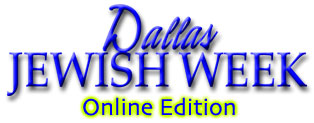| Dallas Jewish Week Menu
|
 |
Flamenco's Jewish roots
Noche Flamenca to perform at GWU's Lisner Auditorium
by Lisa Traiger
Special to the WJW
Anybody who has listened to any Jewish music understands flamenco," Martin Santangelo declares. Santangelo, founder and artistic director of the critically lauded Noche Flamenca should know; he traces the soulful singing and acutely percussive footwork of the art form back to its Jewish, Muslim and Gypsy roots 1,200 years ago on the Iberian peninsula.
Wednesday and Thursday, Santangelo brings his compact troupe of five dancers, two singers and two guitarists to Lisner Auditorium, where, in song, rhythm and dance, the six will delve into the centuries'-old expressive form.
"Flamenco is culturally vibrant," Santangelo explains, "it's not a religious song or religious music or dance form, it's a cultural dance form." That, he says, makes sense to him.
Born in New York to a Jewish father and an Argentinean mother, Santangelo grew in an ethnically mixed, lively household. His father, Edwin Goldin, relocated to the Washington area and now serves as president of Machar, the Washington Congregation for Secular Humanistic Judaism..
His mother, Argentine-born modern dancer Luly Santangelo performed during the 1960s and '70s with Martha Graham and Alwin Nikolais, while also becoming a great fan of the flamenco form.
"Culturally, it's like Lenny Bruce says, if you're born in New York, you're Jewish," Santangelo quips. Though there was no religious school, synagogue or church attendance as Santangelo grew up in the 1960s, he says he was constantly aware of his background and his Jewish roots.
Flamenco entered his life at a young age. The dancer's mother, Luly, became best friends with Mario Maya and his wife Carmen Mora, "two of the best dancers in flamenco," Santangelo explains. The couple lived with Santangelo's family for about four years and a love for the music and rhythm, the ache and joy of the form took root.
"[Maya's] the genius of flamenco choreography, guitar and song," Santangelo continues. "He changed flamenco forever. He made it much more theatrically concrete. I was lucky to be around these people. É I would go to their performances in the Village and I was watching the most pure, the most interesting, the most classic É style. He was revolutionary, like Marlon Brando was for actors -- truthful to the basics of human nature."
Maya's influence has made its way into Santangelo's choreography and direction for Noche Flamenca, especially in the way song, steps and rhythms seamlessly meld. The company has been called passionate, sensational and consistently dramatic by critics and audiences.
At 18 Santangelo began to study flamenco and later settled in Madrid, where his company is now based, although the group spends seven to eight months a year on the road. Married to Soledad Barrio, an acclaimed flamenco dancer who recently received a New York Dance and Performance Award for outstanding creative achievement, the pair has made Noche Flamenca into one of Spain's most successful companies.
"What's so interesting about flamenco is that Arabic and Jewish poetry are side by side," Santangelo says, "and what's so great is that it bypasses most of the religious [purposes]. That makes sense to me as a New Yorker -- there are so many people and races mixed together," he continues.
During the rule of Caliph Abd al-Rahman III from 912 to 961, Cordoba became a center of diversity, representative of the golden age in Spain where Jews, Muslims and Gypsies intermingled and where philosophers, poets, scholars and physicians gathered in the enriched atmosphere. For about 200 years, Jews, Arabs, Gypsies and Christians lived in peaceful coexistence sharing their cultural treasures.
By the 12th century, Santangelo says, 90 percent of the world's Jewish population lived in Spain. The Inquisition, of course, shattered that, as Jews were expelled, murdered or forced to convert during the 15th century. The byproduct of this loss of cultural integration, flamenco song and music, became the chief way to celebrate family rituals, births, weddings and deaths. A folk culture, flamenco's most ancient elements remain the song and the guitar. The flashy percussive footwork, Santangelo says, didn't enter flamenco until 200 years ago. Even later, perhaps within the past 90 years, has flamenco become a performance-oriented art, with programs of staged music and dance.
"Flamenco is a struggle, about a people with no home," Santangelo describes, "a desperate cry that begs, 'leave me alone, let me live and practice what I want to practice.'" This longing expressed through music and dance has made flamenco wildly popular in Israel, but, Santangelo says, equally so in Egypt.
For example, "Siguiriya," whose root meaning is lost, is a profound song that speaks of loss of a loved one in death, but, Santangelo points out, "The sensation of the song, dance and guitar speaks of a loss of a place, of a conflict, a tragedy that happened and then you must go on, somehow. This was sung by the Jews, the Gypsies, the Arabs É it's where east meets west"
"It's not that Jews want to find their expression in flamenco," Santangelo concludes, "Jewish expression made flamenco what it is."
Noche Flamenca, June 19-20, 8:00 p.m. Lisner Auditorium in the District. Tickets are $25, $30, $35. Call 301-808-6900.
This story was published in the WashingtonJewishWeek
on: Thursday, June 13, 2002
Copyright 2001, Dallas Jewish Week